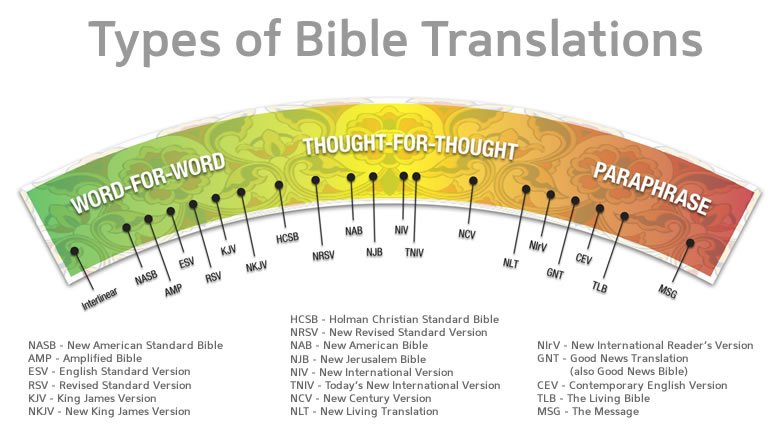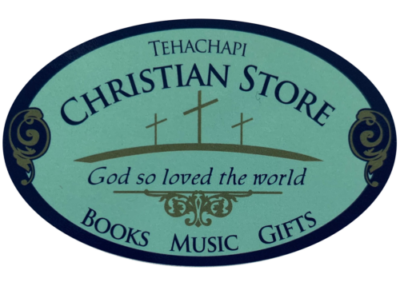Bible Translations

Word-For-Word Translations
Word-for-word or Literal translations are often the closest English form of the Hebrew or Greek word. In this process, translators painstakingly review every single word to ensure they are as accurate as possible, called formal equivalence. This form of translation is extremely helpful for academic study and works well with interlinear Bibles. However, the biggest drawback to word-for-word translations is that modern readers might misunderstand figures of speech, literary devices, and cultural references.
ASV – American Standard Version
Rooted in the work that was done with the Revised Version (RV), the ASV has earned the reputation of being a rock-solid translation of the original Hebrew and Greek texts.
An update released in 2015, the goal of the AMP translation team was to enhance the appeal of the Amplified Bible by refreshing the English and refining the amplifications for relevance and clarity. The result is an Amplified Bible that is easier to read and better than ever to study and understand.
ESV – English Standard Version
To achieve the greatest possible accuracy in an English translation of the original Hebrew & Greek texts, the translators of this readable, modern Bible version attempted to write, as much as possible, a “word for word” rendering of the text. The authors of the ESV, published in 2001, view their work as a continuation in a long line of solid, true, and beautiful English versions of the Bible, beginning with the New Testament of Tyndale in 1526. While modernizing archaic language and correcting certain errors in key portions of text, the translators have moreover labored to preserve the enduring language of their predecessors in a Bible version that is true to every God-breathed word of Scripture.
When William Tyndale (1494-1536) was burned at the stake for translating the New Testament into English in 1526, his last words reportedly were, “Lord, open the eyes of the king!” Shortly thereafter, the Bible was made available in English by royal decree; and in 1604, 85 years after Tyndale’s work, King James I authorized a new translation of the whole Bible for the Church of England. The result was the King James Version of 1611, a work of profound gravity, careful scholarship, and surpassing literary quality. Modern scholarship has led to revisions that strive for greater accuracy and readability, based both on a broader array of Greek texts and on gradual changes in English usage.
NASB – New American Standard Bible
The goal of this popular translation is, “to adhere as closely as possible to the original languages of the Holy Scriptures, and to make the translation in a fluent and readable style according to current English usage.” The NASB is based on the American Standard Version of 1901. The new translation was undertaken in order to incorporate recent discoveries in Hebrew and Greek textual scholarship. Additionally, numerous other translations were consulted, and decisions on the best rendering of the text were made jointly by scholars, educators, and pastors.
The NKJV modernizes the expression of the KJV published in 1611 by King James I of England while remaining true to the original Greek and Hebrew texts and keeping its literary mastery. Biblical scholars consulted a range of church leaders to keep communal worship, Christ-centered learning, and individual devotion in mind while accurately translating this version. Just as the 1611 KJV sought to honor the authority and the precision of the original Greek and Hebrew, this NKJV, published in 1982, deliberately stays clear of paraphrase.
NRSV – New Revised Standard Version
The NRSV, published in 1990, took into account the recent discovery of still older biblical manuscripts that were not available to the translators of the RSV. They also examined linguistic features of the text in more depth and considered changes in English usage. Basing their work on the maxim, “As literal as possible, as free as necessary,” the translators’ desire was to preserve what is best in previous English translations while ensuring high quality and enhanced accuracy.
Thought- for-Thought
Need more context? Looking for an easier read? Thought for Thought or Dynamic translations place a higher emphasis on summing up the biblical authors’ thoughts while still respecting the text. These thought-for-thought translations balance accuracy with approachability, perfect for light reading or a devotion. After all, the Bible is for the common fellow. The drawback though is that every tweak in the name of understandability is a step toward someone else’s textual interpretation. But if you want to draw your own conclusions about every matter, stick with the ‘literal’ category.
CSB – Christian Standard Bible
The CSB aims to draw readers into a deeper, more meaningful relationship with God. By translating Scripture into the clearest possible modern English, the CSB allows readers to experience God’s Word at its fullest. It is a revision of the HCSB, updating translation and word choice in order to optimize fidelity to the original language and clarity for modern audiences.
The CJB expresses the “original and essential Jewishness” of the Bible in both the Old and New Testaments. Without making the text difficult to read, translator David H. Stern incorporates many transliterated Hebrew names and words. His intention is to render the message of the New Testament not from the linguistic, cultural, and theological perspective of the Gentiles, but from that of the Jews, out from whom Yeshua the Messiah was born and to whom, primarily, He ministered before His death and resurrection. For Jews, this translation affords an opportunity to see how the Old Testament prophecies concerning the Messiah are all fulfilled in the New Testament in the person and work of Christ. At the same time, the translation helps Christians appreciate the foundational nature of the Old Testament in relationship to the New Testament.
NAB – New American Bible
This translation, published by the World Catholic Press in 1987 and revised in 2011, is based on the word-for-word principle and undertaken by fifty translators. Unlike previous Catholic Bibles, the NAB is based not on the Latin Vulgate, but on original Greek and Hebrew manuscripts representing the most recent textual scholarship. Although the NAB is intended for official use in the Catholic Mass, its authors collaborated with scholars outside of Catholic circles in an attempt to make the translation more suitable for use by all Christians. This version contains the deuterocanonical books of the Old Testament and complete publisher notes that expand on translation context and meaning.
NIV – New International Version
Striving for faithfulness to the original Hebrew, Aramaic, and Greek texts of the Bible, scholars from five English speaking countries labored to make this contemporary version of the Scriptures readable in style and international in scope. Begun in 1965, published in 1978, and revised in 1983 and 2011, the NIV, has become one of the most popular English Bible translations. The translators’ goal was to produce a work of clarity and literary quality that would be well-suited to private and public reading, memorization, teaching, and preaching.
The New Living Translation is an authoritative Bible translation rendered faithfully into today’s English from the ancient texts by 90 leading Bible scholars. The NLT’s scholarship and clarity breathe life into even the most difficult-to-understand Bible passages—but even more powerful are stories of how people’s lives are changing as the words speak directly to their hearts.
Paraphrase
In your mind, paraphrased translations might already have a bad reputation; we would argue that there is a time and place for every type of Bible out there. Paraphrased Bibles focus on getting the general idea across with clear language, useful for those new to the Faith or new to reading. Sometimes, a paraphrase is nice because it’s an interpretation; you can use it to gain a fresh perspective on a passage you’re reading. Typically, Bible paraphrases aren’t necessarily meant to stand alone, so keep that in mind.
GNB – The Good New Bible
A new translation, (1976), which seeks to state clearly and accurately the meaning of the original texts in words and forms that are widely accepted by people who use English as a language. It attempts to set forth the Biblical content and message in a standard, everyday, natural form of English.
TLB – The Living Bible
The Living Bible is Kenneth Taylor’s interpretive paraphrase of the Bible. Taylor created this paraphrase as a help for those who wanted to read the Bible to children without having to stop and explain many things. The version began in the context of his efforts to explain the biblical text to his own children during family devotions.
MSG – The Message
This translation is a unique Bible-reading experience, a paraphrase by author Eugene Peterson of the traditional Bible text. With no formal language, The Message reads like a letter from an old friend. Because it’s easier to understand, you can better connect what you’re reading with what it means for your everyday life. The Message is not meant to replace your current version of choice. Rather, it is designed as a reading Bible that can give you a fresh perspective on a familiar phrase or passage.
TPT – The Passion Translation
The Passion Translation Bible expresses God’s fiery heart of love to this generation using Hebrew, Greek, and Aramaic manuscripts—merging the emotion and life-changing truth of God’s Word. This translation will trigger inside every reader an overwhelming response to the truth of the Bible, unfolding the deep mysteries of the Scriptures in the love language of God, the language of the heart.
